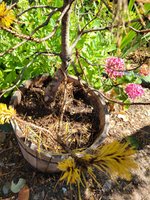My experience with lodgepole pine, shore pine, and variegated foliage on pines generally:
- I have wild-collected lodgepole and shore pines and barerooted them in all 4 seasons successfully (edit: but I do not do so between budbreak and hardening)
- I have successfully cloned wild-collected lodgepole pine through (2 year) air layering
- I have had success bending lodgepole and shore pines into very tight shapes
- I grow three variegated non-lodgepole pines and have improved my results with them over the last few years (1 variegated mugo, 2 variegated JBP) and recognize the Chief Joseph cultivar. I don't own a CJ lodgepole, but I see them often at WA/OR nurseries often and have inspected them up close. IMO their variegation is similar to that of the other variegated pines that I grow except it is more "total" in its expression at peak.
- I have studied and worked with lodgepole and shore pines at Crataegus and Rakuyo gardens over several years
- I've had improving success with turning leggy hard-to-use lodgepole branches into useful/usable branches through the process of seasonally iterative wiring, strategic thinning, and horticulture improvement
- I have nursed back to full health & vigor a few PNW nursery lodgepoles which were greatly overpotted in organic soil by retail nurseries (a potting configuration that your CJ lodgepole has which I believe sets the buyer up for failure unless they intend to ground-grow the tree as a landscape tree). Many of these nursery lodgepoles are B&B'd (ball-and-burlapped), then wrapped in nursery/potting soil, which can complicate things.
If the tree is expanding the size of next year's buds in late July and in person you are convinced that the variegated foliage looks reasonably plump and sharp-tipped and non-flimsy (that last one is key), then the tree is functioning. If that was the case and you gave me this tree to keep for a couple years to flip into a bushier tree my plan would be:
- I'd first do the Neil/Kimura troubled-pine trick and tip the pot on an angle to get it to move moisture out of the pot faster. The angle of tipping I would choose is the one that gave me the largest vertical distance between the lowest part of the pot touching the ground and the highest point of the pot rim above, i.e. the one that rotates the soil mass to have the tallest vertical gravity column possible, even if that gravity column is narrow. I'd perforate the wooden pot for air flow with many drilled holes on the sides and bottom to increase the rate of drying and air flow any way I can (swiss-cheesing isn't pretty but it helps). My singular mission would be to get the soil to go paper-dry down to like 3 inches deep. At time of drying, I'd untip the pot so that it's flat on the ground again, water to saturation, then bob/move the pot in whatever way I could to motivate excess water drippage out. Then I'd re-tip it. That would be my watering ritual until I had done the first big repot and soil volume reduction.
- I'd keep the tree in direct sun but not in a greenhouse. If I felt the variegated needles were getting roasted I'd consider having it in a spot that gets sun-baked until very early afternoon and then drops into shade for the rest of the day, but if the needles weren't getting roasted (in my experience some variegated pine foliage overheats and roasts more easily -- variegated JBP -- while some is completely impervious to overheating -- mugo), then I'd maximize sun
- I wouldn't fertilize much prior to the big repot but if I did it would be very mild and probably with just fish emulsion.
- I wouldn't repot in the year of this post (2024) and would delay that repot till spring 2025
The next part is something where I would feel brave doing it myself but I feel less confident in just willy-nilly telling people to do it this way, but I'd personally do it this way because I see it as "
either do it this way and get the tree back on track quickly OR waste a lot of time on material I should have just passed on to begin with". So with that disclaimer:
At repot time, which I'd do in late winter / early spring, I would reduce the root system down significantly, possibly even down to near grapefruit size, possibly nearly bare rooting the tree. I'd clean away as much organic soil as I could get away with and put the tree in a non-shallow mesh box that wasn't too much bigger than the resulting root volume. The potting media would be coarse-leaning pumice. I'd treat the tree similar to step 1 above except without the pot tipping, i.e. my mission is to see it dry out before I water again and to keep it in full sun. No pruning in 2025. If it was me, I wouldn't prune it for ages really, because I'd first wait till it was healthy enough to wire the branch tips down below the interior shoots/buds and start strengthening the interior. This tree is very sparse compared to what a lodgepole can ultimately hope for in coarse pumice, full sun, infrequent watering, wiring down shoots, and eventually a return to fertilization. If the tree is functioning (week-by-week expansion of buds, take measurements/pictures to gain confidence), then I think you can get there.
Good luck! Lodgepoles are super freakin' tough freaks of nature so there is always a way. They thrive in coarse pumice/lava -- go hike on the eastern slopes of the cascades or in the lava beds and you'll see.





